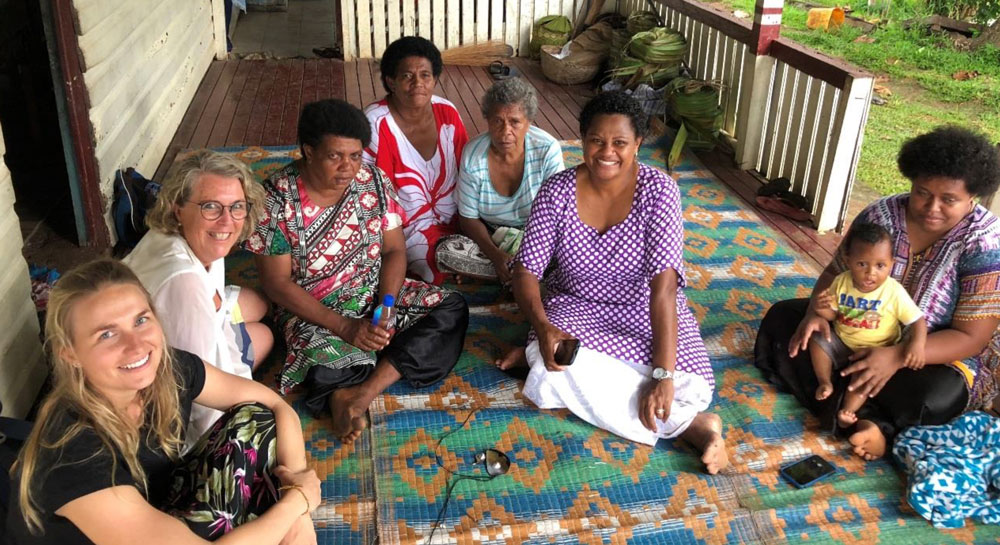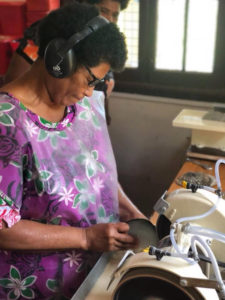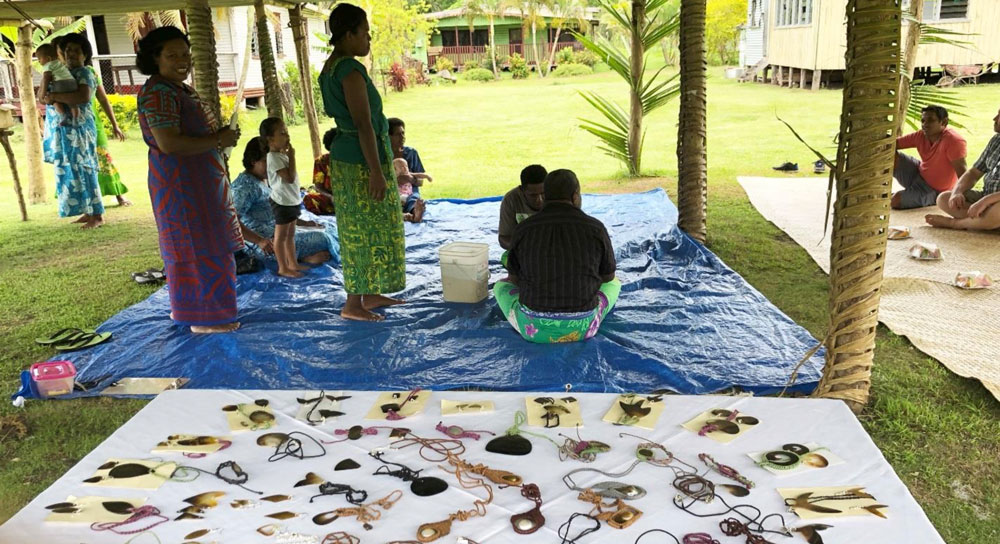

Building Enterprise in the Pearl Industry for Women in the Pacific
March 19, 2019
As part of our efforts to support and encourage young Australians in study, careers and volunteering in international agricultural research, the Crawford Fund State Committees proudly support our International Agricultural Student Awards. The 2018 recipients of these Awards were announced in May, and we are enjoying the process of sharing the journey of these 22 dynamic Australian tertiary students as they gain international agricultural research experience and expertise.
Throughout 2018 and the early part of this year, the successful Award recipients will travel to their host countries to research and explore their chosen topic areas. You can follow their progress here on the Crawford Fund website and read more about their findings, learnings and any challenges they encounter.
To-date we have featured the experiences of University of Western Australia student, Christian Berger; Queensland University of Technology PhD candidate, Thomas Noble; University of Melbourne student, Kimberly Pellosis; Luisa Olmo from the University of Sydney; Rachael Wood from Charles Sturt University; University of Melbourne student Ziyang Loh; Lucinda Dunn from the University of Sydney; Jessica Fearnley from the University of New England; the Australian National University’s Jacinta Watkins, and most recently, University of Queensland Honours student, Tamaya Peressini and the University of Adelaide’s Mathu Indren.
Now, thanks to The Crawford Fund NT Committee, we present to you, Northern Territory Government research officer and University of the Sunshine Coast PhD student Samantha Nowland’s experience focused on community-based pearl farming and handicraft production in the Western Pacific.

Ravita Women’s Group meeting in Fiji
Samantha Nowland undertook a two-week study tour of Tonga and Fiji to visit women’s groups involved in the Australian Centre for International Agricultural Research (ACIAR) project “Developing pearl industry-based livelihoods in the Western Pacific.”
This project builds on past ACIAR research and aims to strengthen collaborative research supporting pearl industry-based livelihoods in Tonga and Fiji and involves many technical aspects of mabé pearl (half pearl) culture and production. The Pearl Livelihoods Project has been successful in developing economic opportunities for women in Tonga and Fiji and Samantha’s study tour focused on the engagement of women in community-based pearl farming and handicraft production.
“The aim of my study tour was to gain hands-on experience and insight into how the project achieves both social and economic success with a focus on how the project works with women’s organisations and, through direct engagement with local women to increase understanding of how they operate,” said Samantha.
“I also hoped to gain an understanding of how the Pearl Livelihoods Project overcomes the challenge of engagement obstacles, including implementing an economic development project in remote rural areas.”
ACIAR pearl projects (including round commercial pearl farming) have been running (not without breaks) for about 20 years in Tonga and longer in Fiji. Women’s engagement is strong throughout the Pearl Livelihoods Project and their inclusion is clearly part of the project design. In Tonga, women’s leadership is strong in the fisheries agencies, where women occupy a number of the senior roles, including the Manager of Aquaculture and two heads of regional Fisheries offices (they look after both Fisheries and Aquaculture), and generally, pearl farming is primarily a family run business.
“We met two women farm owners, Anna (‘Big Mumma’ as she calls herself) and Moa, and all farms (17) had women involved in post-harvest processes such as carving, marketing, and sales. Women who do not have family mabé pearl farms are also indirectly involved in the Pearl Livelihoods Project. For example, we met a woman named Manaseu who does not own a mabé pearl farm but is a talented carver. Manaseu buys mabé pearls and raw pearl shell from local farmers to create jewellery for her stall at the handicraft markets. She was happy that the project was supporting the farmers to supply her with raw material to carve, as the demand is high for local handicrafts during the peak tourist season (May-October),” said Samantha.
“We also met Sophie and Tracy. Sophie moved to Tonga in 2017 to work on the Pearl Livelihoods Project as an Australian Volunteer for International Development (AVID) for 12 months. At the same time Tracy, who is Tongan, worked for Fisheries as the Deputy Head of Aquaculture in conjunction with the Pearl Livelihoods Project. They worked together and became good friends. When we talked with them they reflected on being able to support each other’s work and encourage each other to undertake higher education. This is a great example of women supporting each other to grow and learn, and of how the Pearl Livelihoods Project has been supportive of their development, supporting regional capacity building.”
In Fiji the pearl farmers visited were more geographically remote than those in Tonga, with drives on dirt roads for hours in FWDs to reach some of the villages. In these remote villages the women prefer to work collaboratively in pearl farming and handicraft activities as members of formal women’s groups.
“We visited both the Ravita Women’s Group and Raviravi Women’s Group and both groups included almost all the adult women of the village. There are more obstacles for farming in remote areas, nevertheless it became clear that the more remote you go, the bigger the benefits to women’s lives. An initial key obstacle for the women to engage in pearl handcraft is the lack of mains power in the villages, only a generator that is expensive to run. This makes carving the jewellery from pearl shells very difficult. The project has overcome this obstacle by supplying hand tools and training for grinding, carving, and polishing the shells by hand. The jewellery they make is impressive, high quality and is the result of long hours of work. An alternative for those women’s groups that have too much shell to carve themselves, is to sell the mabé pearls and raw pearl shell to a different women’s group in town, who have access to power tools but not shell.”

Nasomo Ramarama Handicraft Ladies carving pearl shell with machines at skills display in Fiji
This group is called MSF (Marama Shell-craft Fiji) and was established as part of the Pearl Livelihoods Project. Samantha visited the 10 women members of the MSF at their workshop in the town of Ba, Viti Levu. To be part of MSF the women must undertake a year of training to learn handicraft skills and an overseas trainer is regularly brought in by Pearl Livelihoods Project to provide this training. In between the trainer-led workshops there was a lot of peer teaching and learning. The MSF women work three days a week, for eight hours a day.
“The women seem very happy to have a culturally appropriate way to socialise, learn new skills and earn some money,” said Samantha. Further, children are also allowed to be there when the women work, which allows mothers and grandmothers who take care of young children to attend.
“Throughout the study tour I was able to see many learnings that could be applied to our Northern Territory Government’s Tropical Rock Oyster Aboriginal Economic Development Project (NTG Oyster Project). In general, two things we can do better within NT Fisheries are: (1) employ more women in leadership roles within fisheries agencies, we do not do this nearly as well as either Tonga or Fiji; and (2) work more closely with local universities to enable student involvement,” said Samantha.
A tool that has been effective in Tonga and Fiji that could also be applied to the NTG Oyster Project is to provide training as ‘workshops’ said Samantha. This workshop model provides support to communities by bringing in highly skilled trainers and avoids dependence, as the trainers are not part of the project full time.
“One thing we do well in the NTG Oyster Project is supporting different engagement models, depending on what each community prefers, such as: working with the local Aboriginal corporations, ranger groups, and individual family groups. The Pearl Livelihoods Project also does this well and on a bigger scale (more farms involved). It was encouraging for me to see that this approach is scalable and confirms that we are on the right track with the NTG Oyster Project,” said Samantha.

Raviravi Women’s Group meeting and skills display in Fiji (mabé pearl jewellery on table)
In both Tonga and Fiji, the community groups have good governance and the villages receive assistance to develop Community Development Plans and are provided with governance training. This is a major head start in the development of small businesses for these villages, as it helps them to articulate their vision and set goals for their pearl farming enterprises. According to Samantha, this type of governance and planning support is something that could be applied to oyster farming business planning in remote Aboriginal communities, in the Northern Territory.
“The Crawford Fund Student Award allowed me great insight into how the Pearl Livelihoods Project continues to engage and support Tongan and Fijian women in community- based mabé pearl farming and handicraft. It is clear that there is much for us to learn from our regional neighbours that can be applied to our own rural development programs”, said Samantha.
“In my opinion, key success factors of the Pearl Livelihoods Project include: long-term commitment, knowing how to get the right people in the right places, working well with regional government agencies, supporting the next generation of scientists through student involvement, supporting communities to overcome technical obstacles, ensuring flexibility in project design, and either working with groups that have good governance or supporting governance training within the project.”
“Personally, the study tour was an invaluable life experience and I am excited to see how the women progress in their pearl enterprises. I will definitely be back to both Tonga and Fiji. There is nothing that can replace personal experience and I am so grateful that the Crawford Fund appreciate this and enable overseas hands-on experiences, through this Award,” she concluded.




